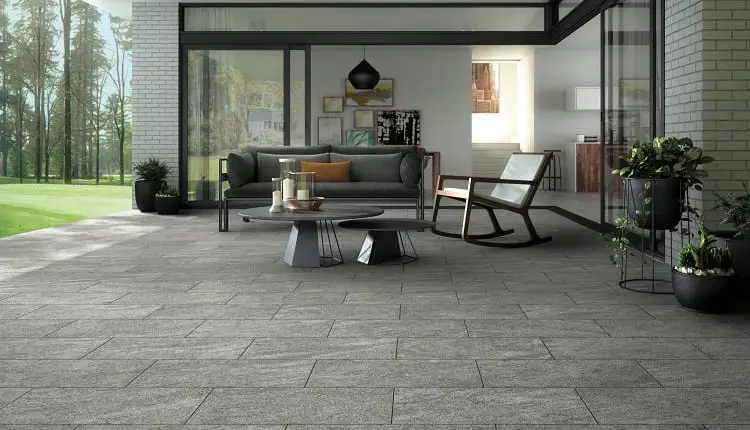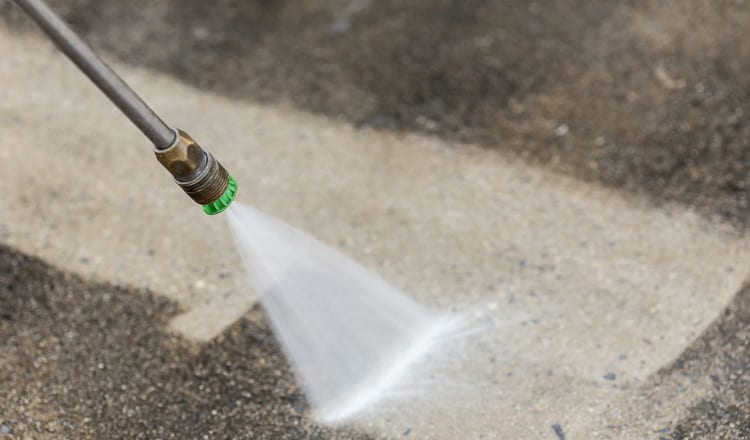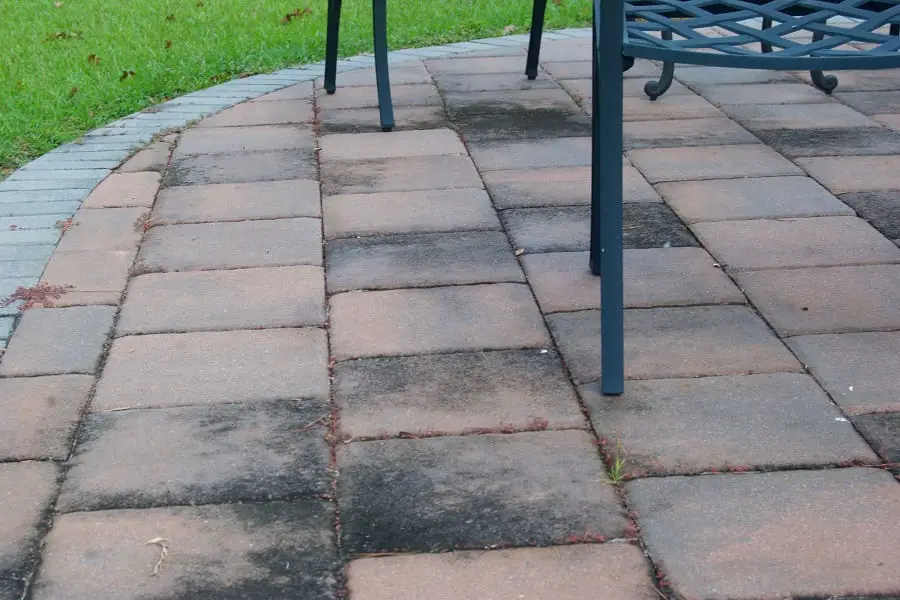If you find mold on your concrete patio, the best thing you can do is attempt to get rid of it as soon as possible. Mold is not just unsanitary and unhealthy, but it also destroys the aesthetic appeal of your beautiful patio.
The good news is that by implementing a few simple steps, you can get your patio mold free again. Of course, this process would involve cleaning and lots of it.
Once you have cleaned and dried your patio, you also need to make sure that moving forward it is cleaned and maintained on a regular basis. This will keep any mold at bay and prevent it from latching on and thriving on your beautiful patio.
Table of Contents
What Causes Mold to Grow on the Patio?

Mold loves warm and damp areas. If your yard has a lot of moisture, standing water and a lot of warm and dark areas, then you most probably are going to find mold growing and thriving.
Once mold settles outside your home, it can grow on nearly anything including sheetrock, wood, and paint. To make matters worse, if you live in an area where there are ongoing moisture and warm conditions, then your mold will have an ideal and highly conducive environment.
Lots of landscapes have been ruined by mold that has gotten out of hand. However, a more pressing issue is the spores that pose a health hazard. If you notice mold in your backyard, get rid of it as soon as you can.
So all mold really needs to grow is a warm and damp environment. So if your concrete patio tends to hold a lot of water or standing water when it rains and if it doesn’t get any sunlight, then it’s probably going to attract a lot of mold and mildew and various other types of fungi.
How to Prevent Mold from Growing on Patio

One of the first things you can do to prevent mold from latching onto your concrete patio is to remove any water immediately with a broom or a mop. Once you find the source of the water, take steps to make sure that it’s not going to collect again.
Once you verify that the water is not draining onto the patio from a gutter or a hole in the roof of the home, make sure the gutter is pointing away from the patio. Remove any tree branches or plants that are hanging or touching the patio.
The concrete patio should be kept clean at all times. Mold, like any other living organism, needs food to live. So removing any dirt will eliminate the food source.
Clean the patio as needed with a solution of 1 gallon of water, half a cup of detergent and a scrub broom. Then rinse the patio with a hose and allow it to air dry properly.
You can also use a commercial mold prevention product, and in fact, it is highly recommended to deter mold from developing on your patio again.
One very important point to remember is that your patio should be kept as dry as possible all the time. Your patio should also be exposed to as much sunlight as possible. Check for signs of mold on flower pots, and furniture as well and try to keep them clean and mold-free.
Types of Mold that Grow on Concrete Patio

Mold is, unfortunately, essential to the natural environment. It breaks down organisms and makes room for new growth. There are literally thousands of different mold species, and they disperse and settle on various objects. Mold can grow on anything from dead trees to concrete and building surfaces.
Most types of mold are harmless to healthy humans, however, they do produce volatile organic compounds that can trigger allergy symptoms, cause respiratory distress and other serious health conditions.
Most types of mold can degrade concrete as well and compromise its integrity and strength. Mold, however, cannot find nourishment in concrete, alone, however, it can feed on algae, moisture, bacteria, dust, pollen, salts as well as dirt and dead skin that is trapped in the concrete.
While most types of mold can grow on concrete, perhaps one of the most detrimental is called Aspergillus. This is a toxic type of mold that causes health conditions in humans. This is also probably one of the most common types of mold that you will find indoors and outdoors as well.
One of the most common types of mold is called Alternaria. It is found in many households, especially those with high humidity levels.
The three main classifications for mold are allergenic, pathogenic and toxigenic. Allergenic molds produce allergies, and allergic reactions such as asthma problems, pathogenic molds cause health problems in those suffering from acute illness.
Toxigenic molds produce toxic substances that can lead to fatal health conditions. This is why it is often referred to as toxic mold. Ultimately, any type of mold found in or around your home is unhealthy and should be eliminated with a sense of urgency.
How to Get Rid of Mold and Mildew from Concrete Surfaces

It can be tricky to identify mold growth on concrete. If it’s black mold then, it’s easy to identify. However, if it’s white mold growth, then you can get a bit complicated. However, there are several similar-looking substances that can fool you as well.
Once you have established that it is indeed a mold growth in your concrete, you need to remedy the situation. Thanks to the extreme durability of concrete, eliminating the mold is a simple process. Unlike carpeting, framing or sheetrock, you don’t need to worry about damaging the material.
However, if it is a rather large area that’s been affected, you should contact a professional mold remediation company. These professionals will bring along specialized equipment such as containment and HEPA filtration.
However, whether or not the mold returns will pertain to the underlying problem. If the problem is related to groundwater intrusion, you will need to resolve the moisture issue in order to keep mold from recurring.
This could be a simple process of redirecting downspouts away from the affected area or sloping the boundaries of the wall. The process itself is relatively cheap and is a well-worth investment.
Sealants are also a great way to prevent mold growth.
Another way to prevent mold growth is to lower relative humidity. Concrete is a poor insulator and tends to become quite cool in winter months.
Too much moisture and poorly ventilated basements, eventually cause moisture to condense on the surface and causes mold growth. So reducing the humidity will be a huge help.
Increasing temperature will also help. In a warm room, the relative humidity is lower. Improving ventilation is also another solution. If all else fails, you can always try a dehumidifier. In certain cases, it may be the only option.
How Often Will I Need to Clean Patio Surfaces?
Well, there is no straightforward answer to this question. Basically, your concrete patio will need to be cleaned as often as is necessary.
If your patio is not in the shade and tends to get a lot of direct sunlight, then you may only need to clean it a few times a year. The same applies if your patio does not hold or retain water when it rains.
However, if your patio is situated in an area of the yard that is covered by trees, then you will need to wash it as often as you see it getting dirty. This will ensure that dirt and grime are eliminated and that mold has no food source to attach itself to and thrive on your concrete patio.
Tips to Keep Your Outdoor Patio Mold Free Longer
In order to keep your concrete patio free of mold for longer, there are a few tips that you should take note of. Firstly, ensure that water is never standing on your patio.
Also, ensure that as much as possible it is in direct sunlight or at least being well ventilated. Also, ensure that dirt and grime are removed from your patios as soon as you notice them.
Your patio should also be washed at least three times a year if it is in direct sunlight and more often if it is not.
Ultimately, one of the best ways to keep your patio mold-free is to ensure that it is clean and dry at all times.
Recommended Tools Need to Eliminate Mold From Patio – Driveway
The most important tools that you need in order to get rid of mold from your patio or driveway include dust mask, eye protection, pressure washer, stiff push broom with deck brush as well as vinegar and bleach.
Recourses:

